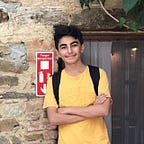A set that includes itself but does not include itself | Russel’s Paradox
In the early 1900s, with a paradox called “Russel’s Paradox”, the basics of the set theory had to go trough some radical changes, but why? And what was this paradox?
Man-eater Paradox[1]:
Assume that you are caught by a group of man-eaters that only eat the people they caught either by roasting or boiling. In order to decide, they ask their preys a question. If they answer the question right, they would be eaten by getting boiled but if they answer it wrong, they would be eaten by first getting roasting. When they catch you as their prey, they ask you the following question: “Will we eat you by first boiling, or will we eat you by first roasting?”. How would you answer this question?
Let’s first assume that you’ve told them that they will boil you. If you are really going to be boiled, then you will answer the question correctly which will be concluded with a result of you getting boiled. In the other case if you are going to be roasted then you would answer the question wrongly; as a result, you will get roasted. However, things turn ugly when you answer the question in the other way. So let’s assume that you’ve answered the question as “I will be roasted!”. If you are really going to get roasted, then you would answer the question correctly and because of the first rule we put, you will be boiled. But… but you were going to be fried. Here is when the paradox comes up.
So how shall we solve this problem? It is very simple and easy: the things we assumed at first, those group of man-eaters cannot be existing and they can’t be asking such question like that!
Barber Paradox:
Assume that you are a barber in a village who only shaves the people who cannot shave itself (the barbers). The question is: Should you shave yourself?
Again; let’s first assume that you should shave yourself. It would be impossible because at the beginning we told that you only shave the people that can not shave itself but you are shaving yourself right -now! Paradox! OK, then let’s assume that you should not shave yourself. When you don’t shave yourself, then you are a part of the people that does not shave itself. However, in the beginning we defined you as a barber who shaves the people that does not shave itself. Then you should shave yourself. Contradiction!
The solution is as same as the one up above, there is no such barber like this. If you want to see more about the paradoxes, you can check the paper of Nesin [1].
RUSSEL’S PARADOX:
All of us have the basic idea of set. In the school, we’ve learned such sets like the sets of natural numbers, integers, rational numbers and real numbers. A set includes some elements and does not contain the others. If a set doesn’t contain any elements, it is called as an ‘empty set’. Let’s take the set {x}. This set has got only one element which is x. We symbolize this mathematically as x ∈ {x}. For example, 7 ∈ N but √2 ∉ N because 7 is a natural number but √2 is not. There are some sets that can contain itself and these are expressed like this in mathematics: X ∈ X. For example, ‘universal set’ is one of them. ‘Universal set’ is a set that contains all the elements including itself. We generally think that all group of elements are sets. Are they really? Let’s see!
Assume that there is a set of the sets that does not contain itself as an element, here we will call it as S. At this point, a natural question arises: Does this set contain itself?
Before we start analyzing just give yourself a minute to understand it, it is not that easy. If you’re ready, let’s start! If we assume that it does not contain itself, it becomes a part of the group of sets that does not contain itself. By the first definition we made, this set contains those kinds of sets thus it contains itself. Contradiction… On the other hand; if we assume that it contains itself, then it must be in the group of the sets that contains itself. Since it is a part of that group, because of the definition, it must not contain itself. Again, a contradiction comes up.
How is the solution then? It is time for you to answer it. There can’t be any set like this, right?
Mathematicians had always thought that all the groups of elements can be a set until this revolutionary paradox came up but as we can see in this set as an example, not all the groups of elements can be a set! For example, still some high school math books defines a set called “universal set” which contains all of the objects including itself. However, they ignore the paradox of Russel. Actually Russel paradox’s is based on Cantor’s diagonalization method [3]. Hopefully, we could examine it in another work. Additionally; if you are interested in, you can check the “Hilbert’s Infinite Hotel Paradox” [2].
References:
1) Nesin, Ali. “Russel Paradoksu.” Matematik Dünyası, 2003, p. 27–32.
2) Polat, Şems. “Hilbert’s Infinite Hotel Paradox.” Edge STEAM, May 2018, p. 2–3.
3) Tychonievich, Luther. “Comparing Infinite Lists.” Indra- Mythology, 24 Oct. 2011, www.cs.virginia.edu/~lat7h/blog/posts/124.html.
